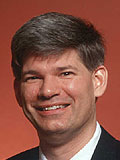Presentation: "50 in 50"
Time: Wednesday 09:00 - 10:00
Location: Store Sal
Presentation: "50 in 50"Time: Wednesday 09:00 - 10:00 Location: Store Sal
Abstract: Languages-what's to learn from them? Relics of the past; we know how to design them / to use them. Types / messages / invocation / loops / numbers / methods / big ol' libraries / lots of = signs. Heh, but what is programming, and what role do programming languages play in that process? We have learned a lot over the last five decades: organizing principles, established conventions, theory, fashions, and fads. "Those who cannot remember the past are condemned to repeat it." In this talk we survey what we think are the most important lessons of the past that future programmers, and future programming language designers, ought not forget. We illustrate each lesson by discussing specific programming languages of the past, and endeavor to shine what light we can on the future.
|
Guy L. Steele, Jr., Sun Microsystems
Guy L. Steele Jr. (Ph.D., MIT, 1980) is a Sun Fellow and heads the Programming Language Research Group within Sun Microsystems Laboratories in Burlington, MA, USA. Before coming to Sun in 1994, he held positions at Carnegie-Mellon University, Tartan Laboratories, and Thinking Machines Corporation. He is the author or co-author of several books on programming languages (Common Lisp, C, High Performance Fortran, the Java Language Specification) as well as "The Hacker's Dictionary" (also known on the Internet as the "Jargon File"). He has served as program chair for four ACM conferences on programming languages and also on the program committees of over 30 other conferences. He has served on accredited standards committees for the programming languages Common Lisp, C, Fortran, Scheme, and ECMAScript. He is an inventor or co-inventor on over 40 computer-related patents. He designed the original EMACS command set and was the first person to port TeX. He is a Fellow of the American Association for Artificial Intelligence (1990) and a Fellow of the Association for Computing Machinery (1994). He has been awarded the ACM Grace Murray Hopper Award (1988), a Gordon Bell Prize (1990), and the ACM SIGPLAN Programming Languages Achievement Award (1996). He has been elected to the National Academy of Engineering of the United States of America (2001) and to the American Academy of Arts and Sciences (2002). Richard P. Gabriel, IBM Research Richard P. Gabriel received a PhD in Computer Science from Stanford University in 1981, and an MFA in Poetry from Warren Wilson College in 1998. He has been a researcher at Stanford University, company president and Chief Technical Officer at Lucid, Inc., vice president of Development at ParcPlace-Digitalk, a management consultant for several startups, a Distinguished Engineer at Sun Microsystems, a Consulting Professor of Computer Science at Stanford University, and lead guitarist for a rock 'n' roll band.
He is a Distinguished Engineer at IBM Research, looking into the architecture, design, and implementation of extraordinarily large, self-sustaining systems as well as development techniques for building them. Until recently he was President of the Hillside Group, a nonprofit that nurtures the software patterns community by holding conferences, publishing books, and awarding scholarships. He is on Hillside's Board of Directors.
He helped design and implement a variety of dialects of Lisp. He is author of four books ("Performance and Evaluation of Lisp Systems," MIT Press; "Patterns of Software: Tales from the Software Community," Oxford University Press; "Writers' Workshops and the Work of Making Things," Addison-Wesley Press; and "Innovation Happens Elsewhere: Open Source as Business Strategy," Morgan Kaufmann), and a poetry chapbook ("Drive On," Hollyridge Press), with two books of poetry in preparation: "Leaf of my Puzzled Desire" and "Drive On." He has published more than 100 scientific, technical, and semi-popular papers, articles, and essays on computing. He has won several awards, including the AAAI/ACM Allen Newell Award.
He is a poet. He lives in California.
Richard P. Gabriel received a PhD in Computer Science from Stanford University in 1981, and an MFA in Poetry from Warren Wilson College in 1998. He has been a researcher at Stanford University, company president and Chief Technical Officer at Lucid, Inc., vice president of Development at ParcPlace-Digitalk, a management consultant for several startups, a Distinguished Engineer at Sun Microsystems, a Consulting Professor of Computer Science at Stanford University, and lead guitarist for a rock 'n' roll band.
He is a Distinguished Engineer at IBM Research, looking into the architecture, design, and implementation of extraordinarily large, self-sustaining systems as well as development techniques for building them. Until recently he was President of the Hillside Group, a nonprofit that nurtures the software patterns community by holding conferences, publishing books, and awarding scholarships. He is on Hillside's Board of Directors.
He helped design and implement a variety of dialects of Lisp. He is author of four books ("Performance and Evaluation of Lisp Systems," MIT Press; "Patterns of Software: Tales from the Software Community," Oxford University Press; "Writers' Workshops and the Work of Making Things," Addison-Wesley Press; and "Innovation Happens Elsewhere: Open Source as Business Strategy," Morgan Kaufmann), and a poetry chapbook ("Drive On," Hollyridge Press), with two books of poetry in preparation: "Leaf of my Puzzled Desire" and "Drive On." He has published more than 100 scientific, technical, and semi-popular papers, articles, and essays on computing. He has won several awards, including the AAAI/ACM Allen Newell Award.
He is a poet. He lives in California.
|
 |
||